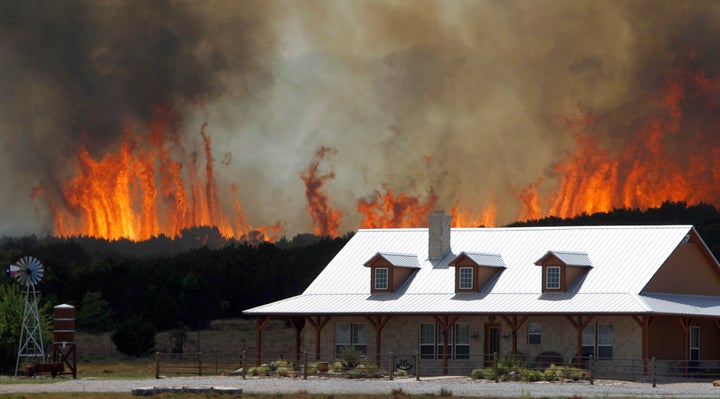
A battle raged in the backcountry of Western Texas last week.
On one side: 35 volunteer firefighters from Brewster County.
On the other: two wildfires, each more than 100 square miles wide and capable of traveling at a rate of one football field per minute when the wind whips up.
The grass of Brewster County, a vast, mountainous region that juts into Mexico, was yellowed and dried up from a seven-month-long drought that meteorologists call the worst in history. The fields provided ample fuel for the flames, and at one point, the fire approached the edge of a residential district, threatening 60 homes.
“It’s been terrible; it’s been horrible,” said Tom Santry, coordinator for emergency management services in Brewster Country. “The grass is extremely dry. We’ve had fires one after the other.”
Finally, the Texas Forest Service stepped in, and by Tuesday the agency had contained 90 percent of the fires. Around the flames that continue to burn, miles upon miles of grazing and grassland lie scorched.
The last two months have been a whirlwind, sometimes literally, of wild weather: The deadliest tornado outbreak since 1932, levels of flooding unseen since the Great Depression. But as Texas’ eastern neighbor, Louisiana, finds itself ankle-deep in water rushing down from the diverted Mississippi River, the Lone Star state is immersed in a climate crisis of its own, complete with months of bone-dry land and thousands of raging wildfires.
The state faces the driest seven-month period ever on record, with less rainfall than it has seen since 1895. Unlike the 2009 Texas drought, which experts touted as the worst dry spell in 50 years and cost the state estimated $3.6 billion in agricultural and cattle losses, this year’s drought is significantly more widespread and threatens to continue throughout the summer months.
As of May 10, nearly half the state -- an area roughly the size of Montana -- was in “exceptional drought conditions.” To meteorologists, these are droughts so rare that they occur only once or twice a century, according to southern region climate specialist Victor Murphy.
The dry spell has spread to nearby New Mexico, Arizona and even Colorado, the eastern parts of which also experience extreme or exceptional drought conditions.
Economic losses from the droughts and the fires are estimated around $3 billion, a result of a ruined wheat crop and a decrease in cattle raising. When winter wheat season rolled around in February, much of the state’s soil was too dry and hard to attempt to plant, explained Texas State Climatologist John Nielson-Gammon.
Ranchers began selling off their livestock after fires scorched the animals’ grazing lands and destroyed miles of fencing. High cattle prices have mitigated the short-term impact for ranchers. But in the long term, the loss of a breeding stock will take its toll, said Nielson-Gammon.
Overall, starting in about mid-March, “each successive day of the drought has an impact of tens of millions of dollars,” he said.
Compounding the problem, temperatures have soared across the state, and last month was the fifth hottest April on record. Residents of Brownsville, a town on the southern tip of Texas just across from the Mexican border, endured an average temperature of 80 degrees and exactly zero inches of rain. Just to the west, the city of McAllen, which lies within the Rio Grande River Valley but is currently in extreme drought conditions, saw days with temperatures in the low 100s, wind gusts up to 40 miles per hour and, of course, not a drop of rain to speak of.
This town and the grassy region to the west is lucky, said local meteorologist Barry Goldsmith, because of its relative proximity to Lake Falcon, still full of water from last year.
But western Texas is much farther from any available water, either standing or falling, and places like Brewster County and regions to the north have seen some of the worst of the flames.
There have been more than 10,000 fires recorded and 436 homes destroyed since wildfire season began on November 15, said Mark Stanford, Texas Forest Service Operations Chief. Heavy rainfall last summer, which created an abundance of grass and shrubbery, has fueled the intensity of the fires.
“It was a nexus of these two factors: The vegetation and then the horrific drought” that led to the unprecedented 10,000 fires this year, said Stanford.
The Texas Forest Service is a relatively small agency, with only 200 employees actively involved in fire response. To help, the Texas National Guard’s resources have also been deployed, and 40,000 volunteer firefighters across the state have also pitched in. Four Black Hawk helicopters dump water and chemical retardants on the flames in 800-900 gallon bursts.
The middle of May traditionally marks a transitional period in the Texas wildfire season. In the winter, the windy conditions spread the fires quickly, making them hard to contain. Come summer, the region’s sweltering heat burns the fires with increased intensity, making them harder to put out. Neither situation is positive for firefighters, and if this year’s season is anything like those over the last decade, the fires will continue to burn throughout the summer months, Stanford predicted.
But May also ushers in the hope of rain, which fell across the state last week for the first time in three months. Even though most areas saw little more than a half an inch, the spring storm gave climatologists hope.
“What’s great about rain in this time of year is that it will allow the grass to green up,” said Stanford. “And green grass doesn’t burn.”
